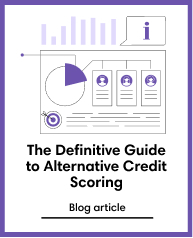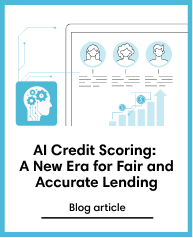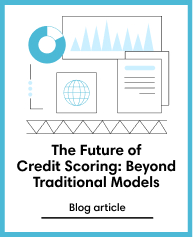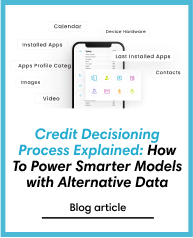Credit Scoring
Mar 2, 2022
How to Combine Digital Footprint Lookups with Behavioural Data to Turbocharge Credit Scoring
Subscribe to our newsletter
In 2022, it’s not just that consumers manage their finances, seek credit, and even think about money has shifted dramatically; it’s also how much of the world’s population is underbanked and unbanked.
Many of these individuals would appreciate access to lending. And neobanks, BNPL companies, micro-lenders, challengers, and fintech in general would like to include them in their customer pool – but they can only afford to do so safely.
The World Bank says that there are 1.7bn underbanked people globally – with 71% of Morocco and 69% of Vietnam, for example, having no such access whatsoever. But even in the US, roughly one in ten people are underbanked per Morning Consult: 10% do not have any bank accounts at all. The same source shows just how big the growth potential for fintech is by estimating that only 24% of Americans have a bank account and use alternative financial services.
Accurate alternative credit scoring is the only way to achieve such growth and often the only way for under or unbanked people to get access to credit.
So let us look at how digital footprint techniques combine seamlessly with behavioural data to provide the optimal balance between providing legitimate customers with useful services and protecting lenders from fraudsters’ malicious intentions.
Investigating Applicants’ Digital Footprint
In the north African nation of Morocco, which we mentioned above briefly, only 71% of the population has access to banking and lending. But, at the same time, internet penetration is at 84.12%, still per World Bank data. In Vietnam, 69% are unbanked; and 70.29% have internet access.
Information gleaned from internet access can thus help us fill in the blanks where there are few or no financial records to learn from. The more people join the online world, and the more time they spend online, the more potent digital footprinting becomes.
It relies on looking at their public, traceable digital activities to find information and reach conclusions – about their financial circumstances, trustfulness and loan/microloan affordability, in our case. SEON conducts data enrichment via digital footprinting techniques to help us assess whether a company is dealing with a legitimate or fake/synthetic user.
The reverse lookup module takes someone’s email address or phone number and combs through openly available information (OSINT) sources to identify hundreds of different data points associated with it.
In simple terms, the type of information we can glean includes:
- Someone’s number of social media/online platform profiles (SEON checks 35+ platforms and growing)
- Has the email been included in a data leak?
- Email provider: free/paid for?
- When was the email domain registered?
- Publicly available user information: does it match?
- When was the oldest data breach this person was victim to?
- and so on.
The answers to these questions comprise a comprehensive risk profile for this person, which will allow us to assess the likelihood of them being bad actors and their overall background, providing alternative credit scoring with several insightful new data points.
Behavioural Analysis Integration and More
The digital footprint lookup functionality is available as API calls as well as part of an end-to-end solution, so it can enrich big lists of applicants easily or help underwriters reach an optimised understanding of individuals during their investigations.
In this way, email/phone data enrichment via OSINT is just one incredibly useful piece of a puzzle that allows fintechs to increase their reach and growth. From there, there are IP analysis algorithms, velocity checks, device fingerprinting, as well as behavioural analysis to generate a complete picture – a 360-degree alternative credit score that can work for almost any applicant, even those new to banking.
Credolab’s smartphone and web metadata analysis is similarly innovative, stacking seamlessly with footprint analysis and the aforementioned anti-fraud staples to provide unprecedented confidence in credit scoring.
Importantly, both methods return real-time, live data, doing away with the all-too-common pitfall of overreliance on potentially stale information that can cause false negatives (and false positives).
The more complete and accurate information one has at their disposal during underwriting, the safer their decision will be for everyone involved. In other words: the more precise their credit scoring will be. And in the digital age, even traditional banks appreciate the need to gauge alternative data to help both customers and themselves.
Nobody Can Afford Friction Anymore
One important note about this synergy is that it remains as frictionless and churn-free as credolab’s solutions. For applicants, digital footprinting and behavioural analysis take place behind the scenes and have the added benefit of keeping the customer journey as frustration-free as legally possible. This is achieved without exposing or compromising the customer’s personal data in a fully privacy-compliant way.
Due to anti-money laundering and anti-terrorism legislation in several of the world’s countries, several local KYC and CDD mandates require organisations to request specific documentation from loan and credit applicants. However, that is the absolute minimum that every lender will request from a resident of that locale and is shared across all those who offer banking and lending products to them.
Behavioural analysis benefits
By combining digital footprint lookups with behavioural data, lenders can obtain at least four clear competitive edges over the competition:
- Smoother customer experience: In addition to meeting legal requirements, extra documents or details at underwriting are requested only from applicants whose risk profiles suggest lower reliability. Lenders can tailor the intensity of hard or soft checks to match each customer’s risk level.
- Accelerated risk evaluation: This approach supports pre-KYC screening and rapid preliminary analysis. By reviewing mobile and web metadata, along with emails and phone numbers at registration, clear fraud attempts can be detected early, saving resources and strengthening security.
- Improved workload allocation: Applicants with borderline initial risk scores can be flagged early, providing teams with more accurate forecasts of affordability checks and underwriting demands.
- Customer-friendly privacy practices: Since lenders request only the essentials for each case, privacy concerns are minimised, and privacy-conscious clients avoid unnecessary intrusion. The data gathered complies with privacy laws, drawing on public and openly available information to assess behavioural patterns that confirm authenticity, without accessing private details.
Overall, this strategy allows lenders to – automatically, if desired – adapt and adjust their approach to each customer. In a sector where churn is such a concern that churn prediction models are increasingly utilised, this can make all the difference in a consumer’s choice of lender.
It also allows those in banking, lending, and fintech to reach more consumers than before, safely and thoughtfully, allowing for new growth for companies and better services for consumers.
About the Author
Gergo Varga has been fighting online fraud since 2009 at various companies – even co-founding his own anti-fraud startup. He's the author of the Fraud Prevention Guide for Dummies – SEON Special edition. He currently works as the Senior Content Manager/Evangelist at SEON, using his industry knowledge to keep marketing sharp, communicating between the different departments to understand what's happening on the frontlines of fraud detection. He lives in Budapest, Hungary, and is an avid reader of philosophy and history.





